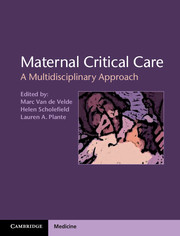Book contents
- Maternal Critical Care
- Maternal Critical Care
- Copyright page
- Dedication
- Contents
- Contributors
- Preface
- Section 1 General non-medical considerations
- Section 2 General medical considerations
- Section 3 Special critical care tools and techniques
- Section 4 The pregnant patient with coexisting disease
- Section 5 Serious problems related to pregnancy
- Chapter 36 Pre-eclampsia
- Chapter 37 Acute fatty liver of pregnancy
- Chapter 38 Peripartum cardiomyopathy
- Chapter 39 Obstetric hemorrhage
- Chapter 40 Anaphylactoid syndrome of pregnancy (amniotic fluid embolus)
- Chapter 41 Maternal complications of fetal surgery
- Index
Chapter 39 - Obstetric hemorrhage
from Section 5 - Serious problems related to pregnancy
Published online by Cambridge University Press: 05 July 2013
- Maternal Critical Care
- Maternal Critical Care
- Copyright page
- Dedication
- Contents
- Contributors
- Preface
- Section 1 General non-medical considerations
- Section 2 General medical considerations
- Section 3 Special critical care tools and techniques
- Section 4 The pregnant patient with coexisting disease
- Section 5 Serious problems related to pregnancy
- Chapter 36 Pre-eclampsia
- Chapter 37 Acute fatty liver of pregnancy
- Chapter 38 Peripartum cardiomyopathy
- Chapter 39 Obstetric hemorrhage
- Chapter 40 Anaphylactoid syndrome of pregnancy (amniotic fluid embolus)
- Chapter 41 Maternal complications of fetal surgery
- Index
Summary
- Type
- Chapter
- Information
- Maternal Critical CareA Multidisciplinary Approach, pp. 438 - 453Publisher: Cambridge University PressPrint publication year: 2013
- 1
- Cited by

